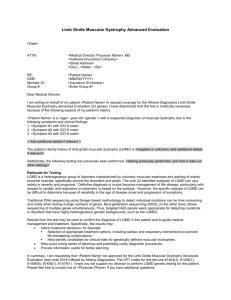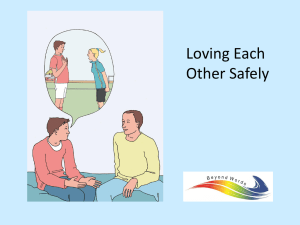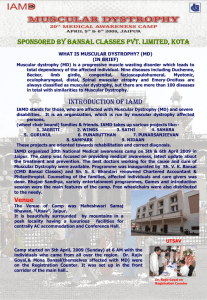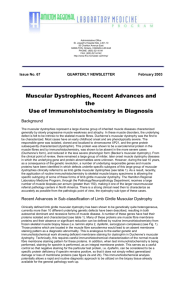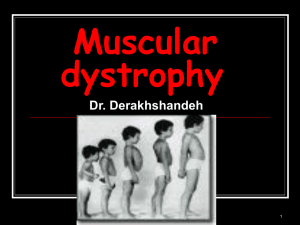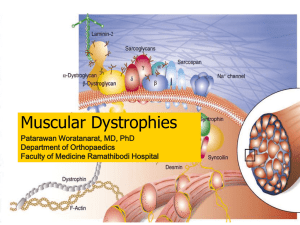Episode 2 PPT
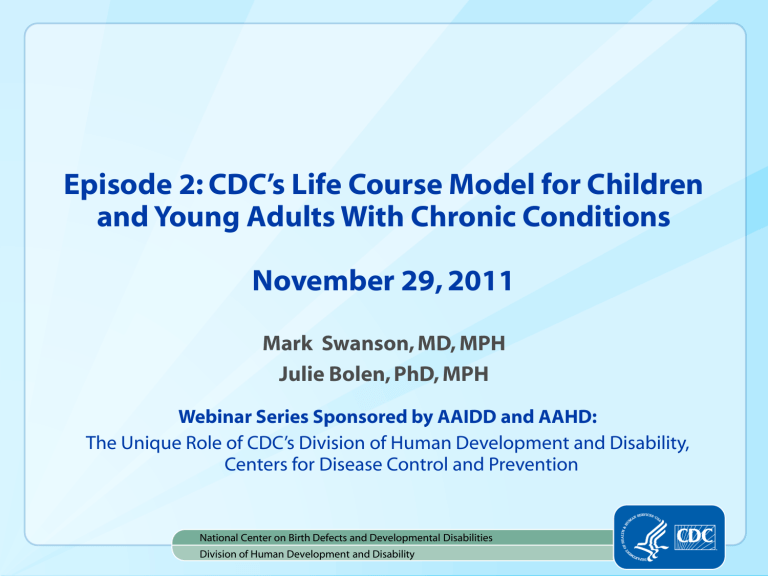
Episode 2: CDC’s Life Course Model for Children and Young Adults With Chronic Conditions
November 29, 2011
Mark Swanson, MD, MPH
Julie Bolen, PhD, MPH
Webinar Series Sponsored by AAIDD and AAHD:
The Unique Role of CDC’s Division of Human Development and Disability,
Centers for Disease Control and Prevention
National Center on Birth Defects and Developmental Disabilities
Division of Human Development and Disability
Webinar Series Overview
Hosted by AAIDD and AAHD
Four-part webinar series
1.
CDC’s Public Health Approach to Disability
2.
CDC’s Life Course Model for Children and Young Adults with
Complex Conditions (November 2011)
3.
Differences in Health Status for People with Disabilities
4.
CDC’s Roadmap for Improving the Health of People with
Disabilities
Key Points You Will Hear Today
1 in 5 Americans have a disability
Important among them are children and adults born with complex conditions
The Division of Human Development and Disability is uniquely tasked to improve the health of people living with these conditions across the life course
The Division’s ongoing work strives to influence others who also work to ensure successful adult living for people with complex conditions
1 IN 5 AMERICANS HAVE A
DISABILITY…AND NOW THEY'RE LIVING
LONGER. WHO'S HELPING THEM ATTAIN
SUCCESSFUL ADULT LIVING?
The Disability Landscape
Globally, there are 1 billion people with disabilities,
~15% of the population (WHO/World Bank, 2011)
In the United States, 54 million people have disabilities
(1 in 5 Americans)
A disability limits the function of a person in relation to the environment and other personal factors
People with disabilities are 4 times more likely to report poor health
$400 billion annually in disability-associated health expenditures in the U.S.
Population of Interest
Complex health conditions have:
Onset in childhood
Cannot be cured
Continue into adulthood
Involve at least one body system that could have an impact on function and participation.
Needs of this Population
Young people with complex health conditions constitute 15-20% of population
(CSHCN survey, 2007) and experience disparities in important functional outcomes, like school, employment and independent living arrangements, doing less well than typical children
They also experience wide variation in outcomes
Across conditions
Within each condition
Functional Areas Affected by Complex Conditions
Overall health status
Self-management of health
Physical activity/Obesity/Nutritional status
Emotional well-being
Employment
Personal relationships
Participation in recreation, spiritual and civic activities in community
Independent living arrangements
(Swanson, Peds Clinic NA, 2010)
Children with Complex Conditions
Children with complex conditions and their families, have the same aspirations for successful adult living as typical children
More people surviving and living longer
Natural history of many impairments is variable or unclear because:
Only recently have children lived well into adulthood
Physical health and functional outcomes have not been documented
Impairments may progress or stabilize, depending on the underlying condition
Needs of this Group
Adverse outcomes may be mediated through inequity in access to services like:
Health services that prepare for adult life
Educational services that prepare for adult employment and learning
Parent training and support
Health literacy
Coordination of health, social and educational services
Public health could play a role in monitoring and making changes in provision of these public services
WE PROMOTE THE HEALTH OF
CHILDREN AND ADULTS WITH
COMPLEX CONDITIONS ACROSS THEIR
LIFE COURSE
CDC’s Division of
Human Development and Disability
Uniquely tasked to improve the lives of people living with complex conditions such as fragile X, muscular dystrophy and spina bifida
Health across life course: Children and Adults
Funding supports DHDD to:
Collect data
Conduct research
Inform evidence-based programs
Bottom Line: Improved quality of life and successful adult living
LIFE COURSE MODEL
International Classification of Functioning, Disability and Health (ICF) defines successful adult living as participation in eight domains. Our Life Course Model focuses on three of those domains.
1.
Interpersonal interactions and relationships
2.
Major life areas
3.
Self-care (management)
INPUTS
PRE-
SCHOOL
SCHOOL-AGE ADOLESCENCE
YOUNG
ADULT
Body
Functions and
Structures
Motor weakness
Cognitive limitations
Incontinence
SELF-MANAGEMENT/HEALTH (self-care)
Body awareness
Begin to share condition mgmt
Take lead on condition mgmt
Manage primary/ secondary conditions
PERSONAL AND SOCIAL RELATIONSHIPS
Peer play.
Emerging
Independence
Group activities outside home.
Chores at home
Friendships.
Independence within family
Relationships.
Community
Interdependence
EMPLOYMENT/INCOME SUPPORT (major life areas)
School readiness
Individuallysupported school success
Education and career exploration
Postsecondary education and training
FAMILY, ENVIRONMENTAL,PERSONAL FACTORS
PARTICI-
PATION
AND
QUALITY
OF
LIFE
LIFE COURSE MODEL
A developmental approach is needed to map trajectory to successful adult living
The bio-psychosocial model is in play here. Successful adult living is the result of interaction between impairment, personal factors and environment over time (a child’s life)
Current clinical approaches to developmental progress often focus on activities (e.g., performance on most standardized tests)
Focus should shift to measurement of participation
(how one fares in the real world)
SPINA BIFIDA LIFE COURSE MODEL WEBSITE
(sbpreparations.org)
4 time points:
Early Childhood
School-Age
Adolescence
Young Adults
3 domains:
Health / Self-Management
Personal / Social Relationships
Education / Employment / Income Support
USE TO FAMILIES AND PROFESSIONALS
Tracks development in key domains across life course
Focus is on positive outcomes rather than deficits
Prompt families to promote normalization
Prompt professionals to track important variables in domains sometimes overlooked in clinical practice
WE GENERATE PUBLIC HEALTH DATA
TO SUPPORT A LIFE COURSE
APPROACH
Bridging the Gap:
Medicine and Public Heath
Medicine Focus is on individual health
Emphasis on treatments and cures
Public Health Focus is on population health
Emphasis on prevention and improving health
The Public Health Approach to Complex,
Childhood Conditions
Step 1: Define the Problem
Step 2: Identify
Risk and protective factors
Step 3: Develop and test prevention strategies
Step 4: Assure widespread adoption
DHDD’s Work: Muscular Dystrophy
MD STARnet (Muscular Dystrophy Surveillance Tracking and Research Network)
Population-based
Identify and gather information on all those with
Duchenne or Becker muscular dystrophy in five states plus Western New York
Details diagnostic timeline, use of genetic testing, clinical signs and symptoms, treatments, and associated conditions
Findings from MDStarnet
Over 800 people, including 220 representing minority groups
~60% survival among 20-24 year olds; more people are living with Duchenne/Becker MD as young adults
First population-based prevalence estimate in the US
(1.3-1.8 per 100,000) males 5-24 years
Diagnostic delay of 2.5 years between first signs and diagnosis. Has not changed in 20 years.
National Task Force for Early Identification of Neuromuscular
Disorders
American Academy of Pediatrics – guidelines to improve early diagnosis of developmental delays
DHDD’s Work: Muscular Dystrophy
Muscular Dystrophy Care Guidelines
Guidelines complete for Duchenne muscular dystrophy
Guidelines under development in conjunction with the
American Academy of Neurology for four additional forms of muscular dystrophy
myotonic dystrophy
limb-girdle muscular dystrophy
facioscapulohumeral muscular dystrophy
congenital muscular dystrophy
DHDD’s Work: Spina Bifida
National Spina Bifida Multi-site Study
Clinic-based
Documents the care received by children and young adults with spina bifida
Measures the results of specific interventions over time
(longitudinal)
Determines which interventions are associated with positive outcomes
DHDD’s Work: Fragile X Syndrome
National Fragile X Family Survey
Survey of 1250 families affected by fragile X syndrome
(FXS) and fragile X-associated disorders. Survey addresses:
Diagnosis
Treatments and services
Adult needs and transition to adulthood
Key pubic health outcomes
Findings from the Fragile X Family Survey
31% of male children with FXS were obese compared to 18% same-aged peers in the general population
47% of families reported FXS caused a financial burden
62% of families reported that parent had to change work hours or stop working
66% of males with FXS exhibited hyperactivity and
38% exhibited aggressiveness
WE CONTINUE TO WORK FOR HEALTHY,
SUCCESSFUL LIVING FOR CHILDREN AND
ADULTS WITH COMPLEX CONDITIONS
DHDD’s Work:
Describe the problem and identify risk and protective factors
Future Projects
South Carolina Study of Adolescents and Young Adults with Rare Conditions
Cross-conditional (FXS, SB, and MD)
Linked administrative data sets – describe experience of people
15-25
Spina Bifida Natural History Project
Testing the school readiness of children with spina bifida as compared to those without the condition
Unique methodology may apply to other rare disorders
Complex Conditions
Current and Future Activities
Need better understanding of:
Health care costs
Economic impact to family
Monitor care and patient outcomes
Access to health care
Quality of life and ability to function
Complex Conditions
Current and Future Activities
Need better understanding of:
Patient’s ability to self-manage
Transition from child to adult health care provider
Promote healthy lifestyle across the course of their life
Evaluate policies supporting access to care, social participation and independence for people with MD
DHDD’s Partners in Public Health
Families
Patient advocacy groups
Professional organizations
Clinicians
State and local departments of health
Government agencies
Academic institutions
Our Public Health Vision for Complex Conditions
Produce data that improves the quality of life for children and adults with complex conditions
Data leads to changes in major service systems, such as health, education and social services
In Summary…
1 in 5 Americans have a disability
Important among them are children and adults born with complex conditions
The Division of Human Development and Disability is uniquely tasked to improve the health of people living with these conditions across the life course
The Division’s ongoing work strives to influence others who also work to ensure successful adult living for people with complex conditions
QUESTIONS
Mark Swanson: cfu9@cdc.gov
Julie Bolen: jcr2@cdc.gov
National Center on Birth Defects and Developmental Disabilities
Division of Human Development and Disability
